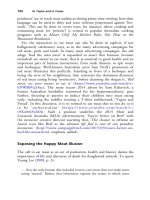The palgrave international handbook of a 237
Bạn đang xem bản rút gọn của tài liệu. Xem và tải ngay bản đầy đủ của tài liệu tại đây (26.42 KB, 1 trang )
232
J. Maher and T. Wyatt
distribute wildlife to order, to collectors or consumers of wildlife products in
the general public (Hubschle 2014). Consumer demand is recognised as the
most significant driver of IWT, and financial gain is therefore the most
common motivation for offending. Nonetheless, motivating factors are
many and complicated; they extend beyond profit to cultural practices
(religion or traditions), status, entertainment and fashion (see Cowdrey
2002). Increasingly animals are captured, killed and forced to endure many
kinds of abuses motivated by fascination with the latest pet trend or fashion
or health craze. The motivations of traders, hunters and consumers can differ
significantly. Organised crime groups may be motivated by financial gain,
political ideologies or instability. Native hunters may be motivated by status
or poverty. Consumers are motivated by desire rather than need wildlife
trade mainly involves luxury goods.
Theoretical Explanations for Abuses in the IWT
As noted earlier, the wildlife trade considerably impacts the animal victims.
Whether this trade is legal or illegal matters not to the wildlife: harms result
from both because these animals are individuals who have intrinsic value and
interest in living unharmed (see Regan’s (1983) ‘subjects-of-a-life’). Thus,
the harms approach taken in green criminology (South et al. 2013) is a
helpful place to begin explaining abuses in the trade. The idea of species
justice (Beirne and South 2007; White 2013) is particularly useful, both in
highlighting the difficulty in explaining harm in the trade and also for
understanding why offenders are motivated to harm. Human interests,
being anthropocentric and speciesist (Beirne 1999), usually override those
of non-human species, creating prejudice leading to the exploitation and
harm of wildlife in ways that are often deemed legal. Essentially, as long as
wildlife are identified as ‘property’, ‘commodity’, ‘product’ or ‘natural
resource’, their needs and interests are ignored, and they will experience
abuse. Within the illegal trade, this is exacerbated as consideration for the
animal’s welfare is unlikely to benefit the offender. Sadly, offenders are less
likely to percieve individual animals to be victims of illegal abuse if those
animals can be harmed by legal means; their actions are more easily justified
and rationalised. Sustained by human interests manifest in capitalism and
consumerism, (White 2013) arguably, both economics and speciesism must
be central to any explanation of abuse.









